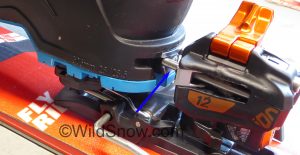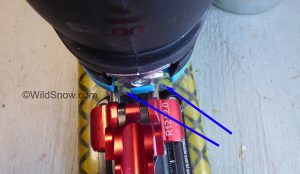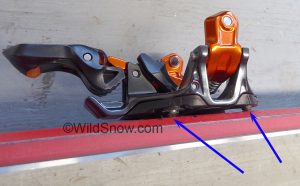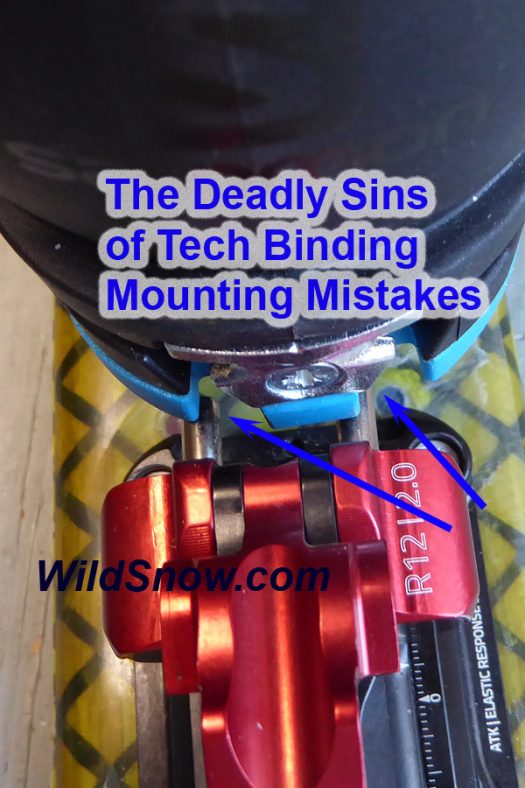Oh boy, mistakes were made? Hopefully you don’t hear that at the ski shop when you’re picking up your shiny new planks. More, let’s hope you are not shouting something stronger when you discover your binding mount is messed up and you’re standing on the summit of Denali — ready to launch — now you get to walk. Most shops (for example our publishing partner and sponsor of this post, Cripple Creek Backcountry) do a pretty good job of quality control. But human error happens. A few of the more common errors below. Some easy to check for, some presented as a warning as to why you should indeed trust your skis only to a top shop.
1. Boot heel off center
Why is this deadly: Too much misalignment preloads the binding heel lateral release, might cause an imbalance in how much retention the binding provides, thus possibly causing accidental release. Less dire, can also make it difficult to step-clip into the binding heel.
How to evaluate: Easy to check when you pick up your skis from the shop. Place boot in binding, in touring mode. Drop boot heel down so it rests on the heel pins (or other, in the case of hybrid binding). Check centering of the heel. It’ll usually be quite close, usually appearing near perfect. That’s best. But being off by a small amount is ok; a millimeter or so.
How to fix on the bench: Assuming the ski touring binding screw holes are not entirely messed up, remove front unit screws, reglue, reinsert screws but leave loose, lock boot in binding, push heel of boot to side until aligned, gradually tighten screws while continuing to apply “English” to the boot.
How to fix in the middle of the Messner Couloir: Not gonna happen.
2. Screw jacked base plates.
Why is this deadly: Simply because the binding screws are not entirely inserted in the ski, and uneven screw pressure can crack the metal binding base.
How to evaluate: Another one that’s easy to spot. Look for binding base plates that are not snugged down onto the ski top. Screw jacking occurs when an inattentive mounting technician tightens screws, and while doing so doesn’t notice the screw threads catching on the binding plate and “jacking” it up off the ski top.
How to fix on the bench: Remove screws, possibly drill out the holes in the plastic base plate to slightly larger diameter, re-mount, taking care to keep plate pressed down on ski.
How to fix during ski tour on Mount Olympus, Greece: Get out your screwdriver, attempt tightening screws. Success may be unattainable due to glue blocking up the holes and preventing the screws from sinking.
3. Stripped screws.
Why is this deadly: This one can be a surprise dumpster fire as your binding toe or heel appear fine, but can come off the ski while you’re skiing. An unexpected and possibly violent fall could be the result. More, it’s likely your ski is lost, perhaps part of your binding. You might be hurt. It’s a long way home.
How to evaluate: Difficult to spot, easy to feel if you do it yourself. This is one where trusting a reputable ski shop to do the job right is your only hope.
Only way to fix: A real fix in the field is nearly impossible, though you can jury rig repairs such as inserting splinters of wood into the hole and re-inserting the screw. Problem is, you usually don’t know about the bad screw until you rip the entire binding off the ski. And where are those trees?

Improper boot length adjustment of a G3 Ion, too much space, correct adjustment involves closing up the gap between boot and binding. Each binding has a somewhat unique specification for this, know yours.
4. Improper boot length adjustment
Why can this be deadly? Wrong adjustment makes accidental release more likely, or even a given.
How to fix on the bench: Sometimes this is tricky, as we’ve even seen bindings with the same model name that require different amounts of space between the boot heel and the binding (known as the “tech gap”). Trust the ski shop — but verify by reading the binding documentation. This blog post goes into adjustment details, is curated, but difficult to keep entirely up to date.
How to fix anywhere: Assuming the binding has enough forward back adjustment to accommodate your boot length, get out your screwdriver and adjust it. Presumably you do know the specification?
5. Missing parts and pieces.
Why can this be deadly? Count the ways.
For a while, a certain binding brand had a removable brake, secured with a small metal clip. Poorly trained technicians often left this in the box or on the floor of the workshop. Even if the clip was installed correctly, you could hardly spot it. The brake would slide off the binding without the clip. Another example: Some bindings have a crampon mount that’s a separate piece — easily forgotten. Again, trust but verify with the binding documentation.
How to fix on the bench: Hold ski shop employee feet to the fire while using other hand to point at the binding document.
How to fix while ski touring a remote volcano in Chile: Duct tape and bailing wire, perhaps a Voile strap if you’ve got an extra.
6. Unglued screws, or wrong glue
Why deadly? Water intrudes into the screw boor, softening the ski core. Screw loosens or pulls out. With a shop mount, ask. They should be using either water resistant white glue, dedicated binding mount glue, or epoxy. We prefer epoxy for nearly all mounts (exception being our tests and demos).
How to fix: Back out one screw at a time, apply glue, re-torque.
How to fix in the field: Tighten screws, ski carefully, glue when you return to civilization.
7. What’s the seventh? Reader’s comment!
Last thought. If you ski much you’ll probably fix a few of these problems yourself, someday. To do so you want a nicely equipped shop of your own. Time to generate that gift list for your significant other.
Tool posts:
Specific to this post, The Tech Binding Tool Set.
And check out 10 tools for the complete home ski shop.
Let’s make it a triad,Yet more tool ideas.
(This post sponsored by our publishing partner Cripple Creek Backcountry.)
WildSnow.com publisher emeritus and founder Lou (Louis Dawson) has a 50+ years career in climbing, backcountry skiing and ski mountaineering. He was the first person in history to ski down all 54 Colorado 14,000-foot peaks, has authored numerous books about about backcountry skiing, and has skied from the summit of Denali in Alaska, North America’s highest mountain.



